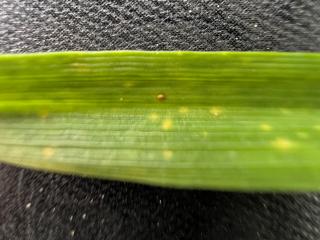Leaf rust in wheat
- Grass Patch
Quenten Knight (Agronomy Focus) has reported finding leaf rust on a Catapault wheat crop near Grass Patch. There were low isolated pustules of rust in the lower canopy, mainly on senescing leaves. The plants were at stem elongation.
Leaf rust pustules are small, circular to oval and can vary in colour from orange to light brown. They usually appear on the upper surface of leaves and on leaf sheaths in cases of heavy infection. Leaf rust requires moisture (rain or heavy dew) or high humidity for spores to germinate and infect leaves. Usually, 4-6 hours of leaf wetness are required at optimum temperatures 15-25°C (warm days and dewy nights) for disease to spread rapidly. The primary risks for carryover of rusts are wheat regrowth and volunteer wheat at edges of paddocks or roadsides. This means that it is worth inspecting as well as planting these crops.
When checking wheat, growers and consultants are also urged to investigate the bottom of the canopy and stems for the presence of stem rust. Stem rust is favoured by warm spring conditions (20-35°C). Stem rust pustules are a darker red-orange and are often found with ragged edges. For more information refer to the Department of Primary Industries and Regional Development (DPIRD)’s managing stem rust of wheat page.
Management
Variety selection is the best defence against rust diseases in-crop. Varieties rated as moderately resistant to moderately susceptible (MRMS) or better will show significantly less rusting than a susceptible (S) variety. These varieties are unlikely to require a fungicide application to maintain grain yield except in exceptional years with very high disease pressure. For variety disease ratings, refer to DPIRD’s 2023 WA Crop Sowing Guide – Wheat.
If rust is detected in a susceptible variety (rated VS to S), fungicide is more likely to be needed to protect yield. In these cases, fungicide should be applied before the epidemic becomes severe, taking into consideration the stage of crop development. Spraying after crop flowering is normally not economic for leaf rust. As the season progresses and warmer, drier conditions occur, the likelihood of an economic response to fungicide will diminish. Spraying decisions should consider the level of disease in the crop, varietal susceptibility, the time of the season and growth stage of the crop. Additionally, consider the chance of ongoing rainfall after spraying, as this is favourable for disease development. Use high rates of fungicide for longer duration of protection, for example, when season conditions favouring infection are likely to persist, or for more susceptible varieties. Cost should be tuned to crop yield potential and crop season length. For a list of registered fungicides to use as foliar sprays, visit DPIRD’s registered foliar fungicides for cereals in Western Australia page.
Rusts predominantly spread via wind from infected plants, but spores can also be transported through the movement of people, machinery and plants. Growers are urged to adopt hygiene (biosecurity) measures during their paddock checks to reduce the risk of spreading the disease. If you are monitoring, the best place to look for rusts is in green plants in tramlines.
Rust pathotype testing
Growers and agronomists are encouraged to send samples of all rusts for pathotype testing at any time of the year to the Australian Rust Survey. Possible new rust strains need to be continuously monitored for as they have implications for existing varieties, and this will assist wheat breeders in developing new resistant varieties. Infected leaf samples should be mailed in paper envelopes (do not use plastic wrapping or plastic lined packages) along with your details and collection information (location, variety etc.) directly to The University of Sydney, Australian Rust Survey, Reply Paid 88076, Narellan NSW 2567. Optional free reply-paid envelopes can be ordered from University of Sydney. For further details refer to the University of Sydney’s Australian Cereal Rust Survey page.
More information
For more information on wheat leaf rust, refer to DPIRD’s managing stripe rust and leaf rust in Western Australia and diagnosing leaf rust of wheat pages.
For more information on leaf rusts, contact Plant pathologists Ciara Beard in Geraldton on +61 (0)8 9956 8504, Kithsiri Jayasena in Albany on +61 (0)8 9892 8477, Geoff Thomas in South Perth on +61 (0)8 9368 3262, Kylie Chambers in Northam on +61 (0)8 9690 2151 or Andrea Hills in Esperance on +61 (0)8 9083 1144.
Article authors: Ciara Beard (DPIRD Geraldton), Andrea Hills (DPIRD Esperance), Geoff Thomas (DPIRD South Perth) and Cindy Webster (DPIRD Narrogin).


